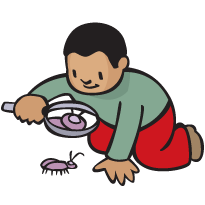Boston Children's Museum
308 Congress Street, Boston, MA 02210
617-426-6500
© Boston Children’s Museum 2025
Website Design by JackrabbitThe goal of Thing-Go Bingo is to have young detectives observe closely, look longer, make predictions and record their findings. This activity not only focuses on observing local environments and data collection, but also provides a chance for your students to build other skills like pattern recognition, problem solving, and communicating.
Make copies of the Thing-Go Bingo (Click for PDF) sheets or create your own using the included sheet as a template. See Figure 1 for an example of a filled-in sheet.

Ask your students to predict the kinds of things that might pass by outside your afterschool center or in a nearby park. Will cars pass by? People? Animals? Garbage trucks? Encourage them to think of both living and non-living things, and encourage them to be creative—rather than just saying “a person,” try “a person with a blue shirt,” etc. Write down anything that is predicted on a piece of chart paper or a chalkboard.
Predict what you will observe when you go outside, then play a game to see if your predictions come true!
When your students have played once, bring them together to talk about what they observed. What are some of the things they saw pass by? Was there anything that they saw that was not on the brainstorm list? Was there anything they were sure they would see that they did not? Have each team fill out a new Bingo sheet.
Play again, as many times as you would like. See Suggestions below for some variations and extensions.